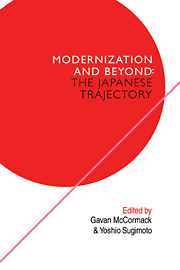Book contents
- Frontmatter
- Contents
- Contributors
- Introduction: modernization and beyond
- I Popular culture: tradition and ‘modernization’
- II Popular movements: alternative visions of ‘modernization’
- 4 Popular movements in modern Japanese history
- 5 For self and society: Seno'o Girō and Buddhist socialism in the post-war Japanese peace movement
- III Uneven development and its discontents
- IV Sex, politics and ‘modernity’
- V ‘Modernization’ and ‘modernity’: theoretical perspectives
- Glossary
- Index
5 - For self and society: Seno'o Girō and Buddhist socialism in the post-war Japanese peace movement
Published online by Cambridge University Press: 04 August 2010
- Frontmatter
- Contents
- Contributors
- Introduction: modernization and beyond
- I Popular culture: tradition and ‘modernization’
- II Popular movements: alternative visions of ‘modernization’
- 4 Popular movements in modern Japanese history
- 5 For self and society: Seno'o Girō and Buddhist socialism in the post-war Japanese peace movement
- III Uneven development and its discontents
- IV Sex, politics and ‘modernity’
- V ‘Modernization’ and ‘modernity’: theoretical perspectives
- Glossary
- Index
Summary
Yukichi, in Osaragi Jirō's novel, Homecoming, says this about his hopes for the future after Japan's defeat in World War Two: ‘Now we've been relieved of the burden of history. If we can make up our minds to march forward completely empty-handed, unhindered by anything from the past, something really new will come to life here in Japan.’ Many Japanese shared these expectations of a ‘new Japan’ after the war, but they soon found that the ‘burden of history’ remained and that in significant ways, the ‘new Japan’ was not so new. This was the experience of the Nichiren priest, pacifist, and Buddhist socialist, Seno'o Girō (1889–1961). Seno'o, along with others in the post-war Japanese peace movement, discovered that his earlier struggles against pre-war fascism and militarism had to be sustained if peace and democracy were to prevail in Japan after 1945.
Seno'o is seldom mentioned in Western scholarship on modern Japan. However, much has been written about him in Japanese. Tokoro Shigemoto, for example, locates Seno'o in a long tradition, going back to Meiji, of an intellectual and political confluence of Buddhism and socialism comparable in many ways to that of Christian socialism. In Meiji, this tradition was epitomized by the zen priest Uchiyama Gudō, who was executed with Kōtoku Shūsui in the High Treason Case of 1911. For Tokoro, Seno'o embodied the same tradition of Buddhist socialism in Taishō and Shōwa.
- Type
- Chapter
- Information
- The Japanese TrajectoryModernization and Beyond, pp. 87 - 104Publisher: Cambridge University PressPrint publication year: 1988



